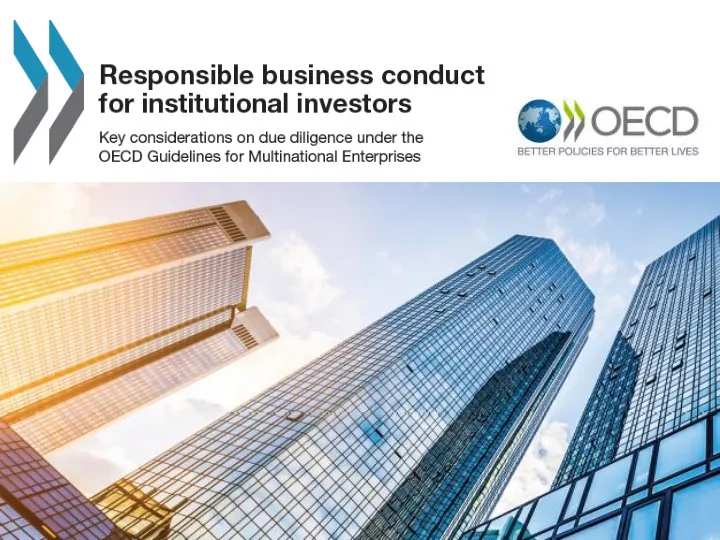

How does OECD lead on Responsible Business Conduct? 1. A comprehensive international instrument on responsible business conduct endorsed by governments – the OECD Guidelines for Multinational Enterprises 2. National Contact Points: The only international RBC instrument incorporating an implementation mechanism 3. Sector specific guidance: The leading standard setter for due diligence guidance (extractive, garment, agriculture, and financial sector) 4. A unique convening power and outreach capacity (Global Forum on Responsible Business Conduct, Investment Policy Reviews, outreach through sector projects or bilateral engagement) .
The OECD Guidelines for Multinational Enterprises set expectations for RBC A comprehensive set of government- 48 Adherents backed recommendations on representing responsible business conduct. • Disclosure • Human Rights • Employment & Industrial Relations • Environment 62% of • Combating bribery, bribe solicitation and FDI Global Inflows extortion • Consumer interests • Science & Technology • Competition 82% of • Taxation FDI Global Outflows .
‘ Golden Triangle ’ for Responsible Business Conduct ILO Tripartite Declaration on MNE’s UN Guiding Principles for Business & Human Rights
A Global Grievance Mechanism for Corporate Responsibility
What makes OECD sector projects unique? Extractive sector Financial Mineral supply Agricultural Garment sector chains supply chains supply chains Demand driven Backed by 48 governments Developed through a multi-stakeholder process representing industry leaders and other stakeholders Whole of value-chain approach
RBC for Institutional Investors: Summary • Key recommendations of the Guidelines and implications for institutional investors • Due diligence for Institutional Investors – Good practice – Key considerations – Due diligence practices by asset class and investment strategy • Annexes: – Terminology – Common Investment Value Chains – Asset Classes and Investment Strategies
OECD Guidelines for Multinational Enterprises – Due Diligence Risk-based due diligence is main tool to identify, prevent or mitigate risk “ Enterprises should: • Carry out risk-based due diligence , (…), to identify, prevent and mitigate actual and potential adverse impacts (…), and account for how these impacts are addressed. • Avoid causing or contributing to adverse impacts on matters covered by the Guidelines, through their own activities, and address such impacts when they occur. • Seek to prevent or mitigate an adverse impact where they have not contributed to that impact, when the impact is nevertheless directly linked to their operations, products or services by a business relationship .” 8
Components of Due Diligence for RBC I: Embedding RBC In Policies & Management Systems III: II: Providing for or Due Diligence: Identify cooperating in and Assess REMEDIATION II: Due Diligence: Prevent and Mitigate II: Due Diligence: Account - Communicating II: Due Diligence: Account - Tracking
Institutional investor relationship to impacts: Directly linked Individual, sponsor Business relationships: “Minority (e.g. employer, shareholding may be considered a government) business relationship under the Guidelines." Asset Owner (e.g. pension fund, Direct linkage : “ the existence of BUSINESS RELATIONSHIPS government ministry) RBC risks (potential impacts) or actual RBC impacts in an investor’s own investment portfolio means, in the vast majority of cases, there is direct linkage." Investment manager Company A Company B Investment RBC Company C portfolio Impact 10
Institutional investor relationship to impact: Contributing “In some instances investors may be contributing to impacts caused by their investee companies and may be responsible for remediation. These situations could arise where investors wield significant managerial control over a company, for example, in certain General Partnerships .” 11
Risk-based Prioritisation • Prioritisation should be based on severity of risk - Scale, scope, irremediable character 12
Management Systems: Key considerations • Building on existing frameworks (e.g. ESG integration) • Using policy to signal prioritisation • Recognising alignments between financial materiality and RBC risks
Identifying actual and potential impacts : Key considerations • Applying a risk-based approach • Responding to information deficits • Assessing credibility of information
Seeking to prevent and mitigate adverse impacts: Key considerations • Leverage limitations • Considering divestment and exclusion •
Deciding when to end a business relationship 16
Accounting for due diligence and how adverse impacts are addressed: Key considerations • Balancing transparency and confidentiality • Expectations of non-financial disclosure in law and among beneficiaries • Risk mitigation through transparency
Processes to support remediation: Key considerations • Establishment of a grievance mechanism • Engagement with National Contact Points (NCPs)
Thank you/ Merci! Contact Barbara Bijelic Legal Expert, OECD barbara.bijelic@oecd.org +33 (0) 1 45 24 18 75
Recommend
More recommend